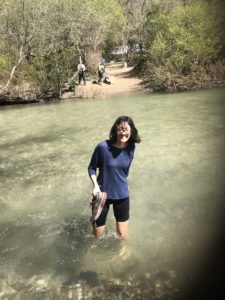
Picture is from when I was visiting a nature reserve in California, a biodiversity hotspot in the world. Now in the Arctic, the opposite of any hotspot. Crossing a river here is much less pleasant.
My background is both from the natural sciences and the humanities. When I studied the humanities several years ago, I felt the environmental issues were absent (it has become better now, but a bit too late for me). In these times, it felt wrong to continue studying a discipline that was totally indifferent to the natural world. That is the main reason why I then started to study biology. (However, I have not left the arts, I recently wrote a novel about a botanist that got published earlier this year.)
I have a special interest in ecology, genetics and evolution combined, also on how species change in their relationship to human activities (and vice versa, for that matter). My home university is the Norwegian University of Life Sciences, where I have learned a lot about polyploidy in domesticated grasses. I find polyploidy and the mechanisms around it very interesting, however I was not very keen on doing research on a domestic species. That is why I am currently doing my master thesis about autopolyploidy in the arctic-alpine species Saxifraga oppositifolia in Svalbard instead.
In my fieldwork, I am studying individuals of S. oppositifolia along a bioclimatic gradient. The aim is to find out if the individuals with different ploidy-levels have different preferences for several factors, such as pH, temperature, moisture, and if individuals of different ploidy-levels differ from each other in the capability to compete with other species. Even though I am not looking at functional traits, I thought I’d maybe learn something useful about research along gradients and how to use these data during the course. My goal is to understand my own research better by participating in the group work. New ways on how to think about things often come by doing something slightly different than one usually does. I will know that I have reached the goal when I start to relate my own project to what we will be doing.
Since I am already staying in Svalbard for the summer and the fall (and have been here on several occasions earlier), my excitement for the Arctic have already been met. Still want to see a flowering Arctic dandelion, though, but as much as I have already been in the field around Longyearbyen, I doubt we will find one (I hope I am wrong). I think I am mostly excited about learning new things and meet new people.
While I have been here in Svalbard, I have thought a lot about how little environmentally friendly it is to stay here. The towns run on coal, it takes a long airplane flight to get here, and all food and other supplies must travel a long way to come to the archipelago. I think it is quite ironic that coal mines are shutting down and getting replaced by tourism and research, with all the pollution of greenhouse gasses such a large transportation of people those sectors involves. In addition, we used more than 1800 pieces of plastic packaging to sample everything we needed from the plots we set up in the field. It is not very environmentally friendly to be a scientist, I must say. However, my impression is that it is not very popular in Norway to suggest having no people on Svalbard, because if not Norwegians, then somebody else (Russians? Chinese? Americans?), and god forbid that to happen! Despite that, I feel most people in Norway accepts that the planet is warming, and that this is largely caused by human activities – at least on paper and when people talk. When it comes to the politicians’ actions, I am not so sure anymore. Talking green, while doing grey does not do any difference. It is even worse than honest politicians that at least say out loud they don’t want to do anything about the environmental issues. I used to be an active member in an environmental organization for years, because I believed it was possible to do something. Now I have lost my hope, and instead started to accept the fact that the world is changing for the worse, and we just have to deal with it somehow.